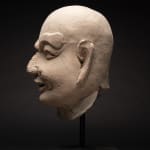Song period stone head of a Lohan, 960 CE - 1279 CE
Stone
height 33.3 cm
height 13 1/8 in
height 13 1/8 in
RL.0994
Further images
After the collapse of the Tang Dynasty (906 AD), there was a succession of short-lived governments, known as the Five Dynasties. This period of relative unrest came to an end...
After the collapse of the Tang Dynasty (906 AD), there was a succession of short-lived governments, known as the Five Dynasties. This period of relative unrest came to an end with the establishment of the Northern Song Dynasty in 960 AD.
Renewed political stability helped to usher in a period of economic prosperity and a massive rise in population.
Amongst the numerous achievements of the Song Dynasty was the development of Neo-Confucianism- a philosophical movement heavily influenced by Buddhist teachings. Although Buddhism had reached China from India during the Han Dynasty, it took considerable time for the new faith to make an progress. This was partly because it had to compete with native ideologies, namely Confucianism and Daoism. It was possible, however, to find common ground between these belief systems and by the era of the Tang Dynasty, Buddhism was experiencing a golden age in China.
Even today, when entering the main hall of a Buddhist temple in China, one will always admire two rows of sculpted figures, traditionally numbering eighteen in total. These figures are known as the Eighteen Lohan. Lohan is the Chinese term, derived from the Sanskrit word Arhan, for a disciple or follower of Buddha who has reached a state of enlightenment. The Lohan had been a popular subject in Chinese art, at least since the cultural flourishing of the Tang Dynasty. Traditionally, they are always produced in sets of sixteen or eighteen, with the numerical difference bein result of discrepancies in Buddhist texts. By the Song Dynasty, artists began to depict each Lohan with individualized facial features. Having achieved enlightenment, Lohans were free from all earthly desires and no longer subject to the cycle of rebirth.
Serenity and wisdom are implied by the evident wrinkles and the Lohan's stoical expression.
Renewed political stability helped to usher in a period of economic prosperity and a massive rise in population.
Amongst the numerous achievements of the Song Dynasty was the development of Neo-Confucianism- a philosophical movement heavily influenced by Buddhist teachings. Although Buddhism had reached China from India during the Han Dynasty, it took considerable time for the new faith to make an progress. This was partly because it had to compete with native ideologies, namely Confucianism and Daoism. It was possible, however, to find common ground between these belief systems and by the era of the Tang Dynasty, Buddhism was experiencing a golden age in China.
Even today, when entering the main hall of a Buddhist temple in China, one will always admire two rows of sculpted figures, traditionally numbering eighteen in total. These figures are known as the Eighteen Lohan. Lohan is the Chinese term, derived from the Sanskrit word Arhan, for a disciple or follower of Buddha who has reached a state of enlightenment. The Lohan had been a popular subject in Chinese art, at least since the cultural flourishing of the Tang Dynasty. Traditionally, they are always produced in sets of sixteen or eighteen, with the numerical difference bein result of discrepancies in Buddhist texts. By the Song Dynasty, artists began to depict each Lohan with individualized facial features. Having achieved enlightenment, Lohans were free from all earthly desires and no longer subject to the cycle of rebirth.
Serenity and wisdom are implied by the evident wrinkles and the Lohan's stoical expression.











